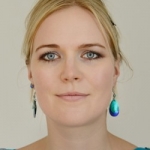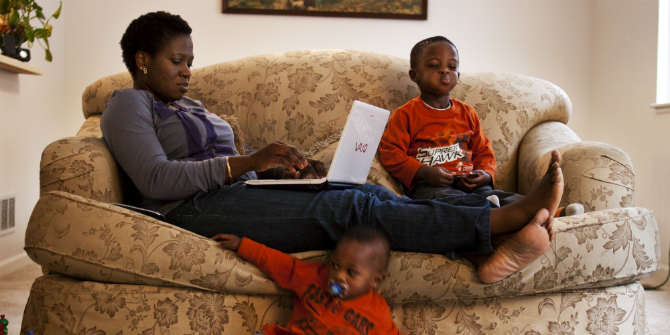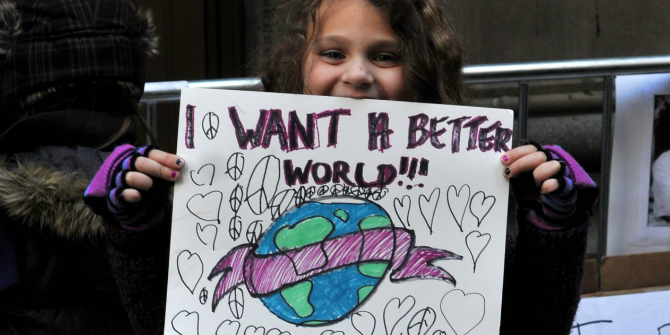 How have digital books changed the reading experience for children? As summertime is a prime season for parents to read to, or read with their children, in this post Natalia Kucirkova outlines the factors that affect ‘reading for pleasure’ in the context of digital books. Natalia argues that digital books have reinvigorated interest in the ‘materiality’ of children’s reading, as she questions the ways in which children physically interact with the page and characters of the books. Natalia is Senior Research Associate at University College London, Institute of Education. Her research focus on children’s reading on screen and how this affects their understanding of stories, language development and parent-child interaction. [Header image credit: E. Sivan CC BY-NC-SA 2.0]
How have digital books changed the reading experience for children? As summertime is a prime season for parents to read to, or read with their children, in this post Natalia Kucirkova outlines the factors that affect ‘reading for pleasure’ in the context of digital books. Natalia argues that digital books have reinvigorated interest in the ‘materiality’ of children’s reading, as she questions the ways in which children physically interact with the page and characters of the books. Natalia is Senior Research Associate at University College London, Institute of Education. Her research focus on children’s reading on screen and how this affects their understanding of stories, language development and parent-child interaction. [Header image credit: E. Sivan CC BY-NC-SA 2.0]
Accordion books, pop-up and movable books, books with animal fur, mirrors and edible corners – there has been an explosion of interest in these types of books by children’s publishers. Whether this is in response to the rise in ‘non-material’ e-books or increasingly sophisticated technologies, it is difficult to tell. What is clear is that while printed picture books offer many additional and enriching opportunities for young readers, digital versions have raised the profile of dimensions that are central to children’s learning and development.
Six dimensions that affect reading for pleasure
Professors Cremin, Littleton and I theorised six dimensions that affect children’s reading for pleasure and that are brought to fore with digital books. These are used as part of the UKLA Children’s Digital Book Award when evaluating children’s digital books in their classrooms, as well as by researchers in DigiLitEY COST Action looking at the quality of children’s digital books.
The six dimensions involve:
- Sustained engagement: children engage in different activities, characters and stories over time.
- Shared engagement: children read with others, either in person or virtually.
- Interactive engagement: children get clear feedback and encouragement from digital books that have goals and rules.
- Affective engagement: children feel included and empowered during reading.
- Personalised engagement: children can make the book their own by by adding their own voiceovers, pictures or story characters etc.
- Creative engagement: children can use their imagination, make up new stories or change what is happening.
Could the ‘materiality’, or children’s physical engagement with books as objects and sensory materials, be a seventh dimension implicated in their reading for pleasure?
A workshop to explore the importance of materiality
I recently attended a workshop, ‘Material, Spatial and Sensory Encounters with the Picturebook Object’, at the Koc University in Istanbul, Turkey. This offered an inspiring debate among international literary scholars, psychologists, artists, librarians, illustrators and children’s publishers. The speakers discussed, and demonstrated with a number of book examples, how materiality in picture books promotes children’s sensory experiences, including touch, taste and smell.
The organiser, Associate Professor Ilgim Veryeri Alaca, a children’s author herself, has been researching and pondering the importance of materiality in children’s picture books for many years, and is currently exploring edible books. The detailed analyses of selected picture book titles (from classics such as The Very Hungry Caterpillar to Press Here) led me to consider materiality as a specific book feature that influences the child’s learning as well as the parent–child interaction during book reading.
Meaning-making
Materiality plays a crucial role in the reading experience of emerging readers or non-reading children. As you can see in this short video, babies treat books as objects. They like to chew on them, turn them over, hide underneath them, throw and touch them. They like to explore the weight, shape, texture and visual properties of books, and these explorations are implicated in their cognitive and affective development.
Meaning-making through material explorations with books is a different experience with digital picture books. While traditional children’s picture books are made of non-toxic materials and their shape and weight are tailored for young children’s behaviour (including chewing and banging with their fists), e-books are all one size and don’t offer the same options for physical interaction.
As the texture is the same for all digital books, children need to distinguish between some complex combinations of touch-manipulable possibilities embedded in the digital books. In one study in 2014 with very young children, researchers concluded that they show a set of different touch types with iPad and paper, and that the touch repertoire with iPads is different in terms of tapping, pressing, straight or circular strokes.
The multidirectional nature of digital reading – the possibility of tapping on several hyperlinks but also taking part in several activities (watching CBeebies or playing Mario Kart) all within one screen – intensify children’s awareness of the different consequences their touch has on screen.
The value of materiality
Key insights into the value of materiality become apparent when we reflect on hybrid books. Augmented reality children’s books are a niche, but rapidly growing, market, with some exciting innovations. For example, when children or their parents point a smartphone at the Goodnight Lad book, the story characters start dancing and playing on top of each page. Virtual reality is part of the child’s physical reading experience, and therefore contributes to their meaning-making and learning.
We need patient, longitudinal research to draw conclusions about the influence of these material and non-material encounters on children’s learning. Many international scholars are actively trying to understand the features that may influence the reading process and reading outcomes, as showcased in a recent special issue in the Journal of Child-Computer Interaction.
While researchers are busy formulating their reflections into empirical studies and deeper theoretical debates, designers are creating, and parents and children are experiencing, a rich spectrum of stories. All adults need to ensure that children experience a materially rich reading diet.
This post gives the views of the authors and does not represent the position of the LSE Parenting for a Digital Future blog, nor of the London School of Economics and Political Science.





